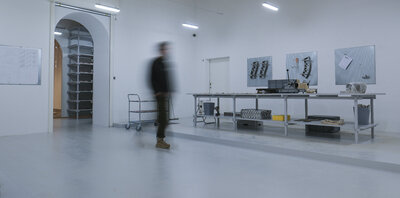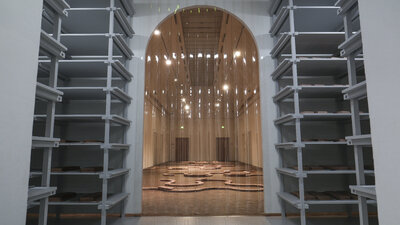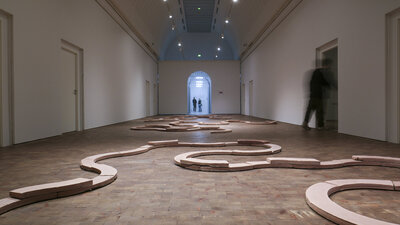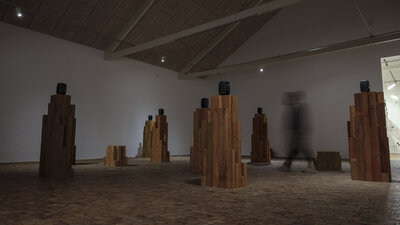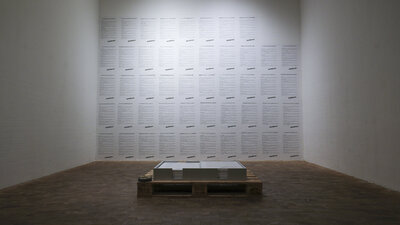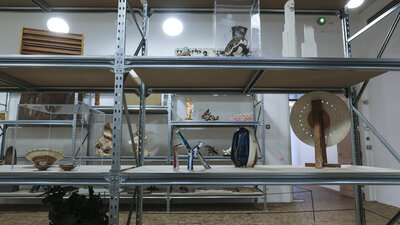SUPERFLEX and Asger Jorn: Superconversation
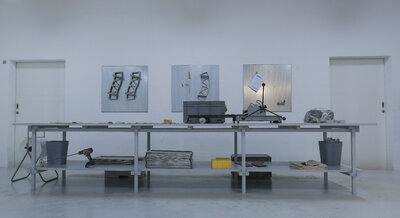
SUPERFLEX was conceived as an expanded collective and has consistently worked with a wide variety of collaborators. Recent works have taken the idea of collaboration further, soliciting the participation of other species. For Museum Jorn, SUPERFLEX brings Asger Jorn and others into the collective, presenting new and recent works alongside a selection of pieces from the museum’s collection.
Using AI text generators and voice cloning technology, SUPERFLEX produced Superconversation, a dialogue between nine artists in the collection. Springing from an interest in what these artists would have to say today, the work brings them back to life to talk about the future of museums and the continued relevance of their practices in a transforming world.
The dialogue is an audio work that puts the visitor in the middle of the conversation. The speakers are situated on pedestals built from the wooden bricks that comprise the floor of the Jorn Museum. This flooring is set in bitumen, a viscous liquid that moves incredibly slowly. It is an uncontrollable substance that changes shape depending on humidity and temperature, so that the floor of the museum shifts unpredictably over time. In this way, Superconversation reflects not only on utopian ideas for museums, but also on the room that the work occupies.
In the large exhibition space, SUPERFLEX presents another new work, Superbrick Factory. The “superbricks”—pink, curved bricks made from unfired clay that are constructed to avoid the right angles and straight lines of human architecture—are produced inside of the museum and used to construct sculptures in the space. After the exhibition, the sculptures will be placed around the museum’s grounds, where it will function as sculptural infrastructure. The unfired clay will eventually return to earth, disrupting the museum’s logic of continuous preservation and instead suggesting a cyclical relationship to time. Superbrick Factory is in dialogue with a number of historical works in Museum Jorn’s collection, including Per Kirkeby’s brick sculptures, which propose a relationship between geology and architecture, and Jørn Utzon’s original design for the museum, which envisioned the museum almost as a curving, branching organism.
In addition to these new works, SUPERFLEX will show other recent works, including All Is Water, a film featuring a speculative text spoken and written by an AI that moves from meditations on the history of science to an almost mystical exploration of fish consciousness; As Close As We Get, a series of sculptures that function as art for humans and as potential homes for fish.; and Interspecies Architectural Manifesto, a list of propositions for designing buildings to meet the needs of other species.
Jean Dubuffet said about Asger Jorn, “Tumult was his element; in tumult, he felt like a fish in water.” Jorn himself proposed creating a “Ministry of Disruption” (“Ministeriet for Forstyrrelser”). Similarly, SUPERFLEX often talks about cultivating friction, a necessary ingredient for collectivity. In that spirit, the exhibition also includes artworks from a number of artists in the museum’s collection—including Asger Jorn, Sonja Ferlov Mancoba, Joseph Beuys, Jørn Utzon, and others—highlighting the resonances and dissonances between their practices. By including Jorn and others in the expanded collective, SUPERFLEX facilitates a conversation between artists across time—a debate about how to prepare for an uncertain future.
